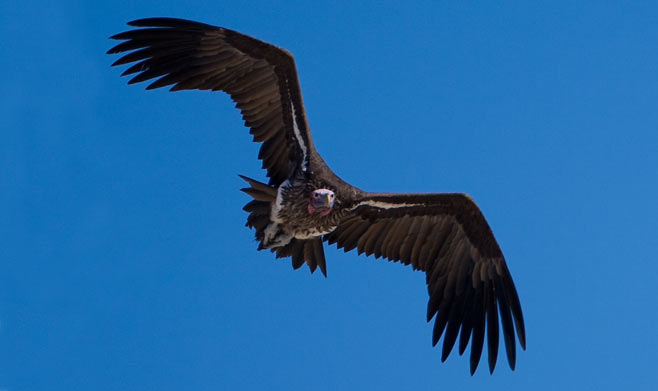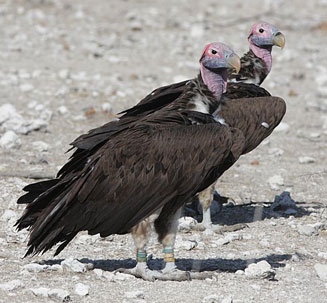|
Aegypius tracheliotos
(Lappet-faced vulture)
[= Torgos tracheliotus]
SwartaasvoŽl [Afrikaans]; Isilwangangubo [Xhosa]; iNqe
[Zulu]; Ekuvi (generic term for vulture) [Kwangali]; Letlaka-pipi [South
Sotho]; Lenong le leso [North Sotho]; Gora (generic name for vulture)
[Shona]; Lingce (generic term for vulture) [Swazi]; Koti (generic term for
vulture) [Tsonga]; Bibing, LenŰng [Tswana]; Oorgier [Dutch]; Vautour
oricou [French]; Ohrengeier [German]; Abutre-real [Portuguese]
Life
> Eukaryotes >
Opisthokonta
> Metazoa (animals) >
Bilateria >
Deuterostomia > Chordata >
Craniata > Vertebrata (vertebrates) > Gnathostomata (jawed
vertebrates) > Teleostomi (teleost fish) > Osteichthyes (bony fish) > Class:
Sarcopterygii (lobe-finned
fish) > Stegocephalia (terrestrial
vertebrates) > Tetrapoda
(four-legged vertebrates) > Reptiliomorpha > Amniota >
Reptilia (reptiles) >
Romeriida > Diapsida > Archosauromorpha > Archosauria >
Dinosauria
(dinosaurs) > Saurischia > Theropoda (bipedal predatory dinosaurs) >
Coelurosauria > Maniraptora > Aves
(birds) > Order: Falconiformes
> Family: Accipitridae
> Genus: Aegypius
 |
|
Lappet-faced vultures, Mkgadikgadi Pans, South
Africa. [photo Gerhard Theron
©] |
 |
 |
|
Lappet-faced vultures, Etosha National Park,
Namibia. [photo
Trevor Hardaker ©] |
Lappet-faced vulture, Kgalagadi Transfrontier
Park, South Africa. [photo Trevor Hardaker ©] |
Distribution and habitat
Occurs in Israel, the Arabian peninsula and patches of
sub-Saharan Africa. In southern Africa it is uncommon in
Botswana, Zimbabwe, Namibia, small areas of Mozambique and northern and eastern
South Africa. It generally prefers arid and semi-arid open woodland, especially
with Acacia, Shepherds-tree (Boscia albitrunca), Purple-pod cluster-leaf
(Terminalia
prunioides) and Mopane (Colosphermum mopane).
|
 |
|
Distribution of Lappet-faced vulture in southern Africa,
based on statistical smoothing of the records from first SA Bird Atlas
Project (©
Animal Demography unit, University of
Cape Town; smoothing by Birgit Erni and Francesca Little). Colours range
from dark blue (most common) through to yellow (least common).
See here for the latest distribution
from the SABAP2. |
Predators and parasites
- Predators of chicks
- Predators of eggs
Movements and migrations
Little known, although it might be nomadic in
the non-breeding season.
Food
It is mainly a scavenger, focusing on the skin, tendons and
ligaments of carcasses that other birds struggle to handle. It is the largest
and thus the dominant vulture of southern Africa, sometimes charging at other
vultures like in the photo above. The carcasses it feeds on vary in size from
the Vervet monkey (Cercopithecus
aethiops) to Impala (Aepyceros
melampus) and African elephant (Loxodonta
africana). The following food items have been recorded in its diet:
- carrion
- stranded fish
- birds
- mammals
Breeding
- Monogamous, territorial solitary nester, probably with a lifelong pair
bond.
- The nest is built by both sexes, consisting of a large platform of
sticks lined with dry grass, hair and skin. It is typically placed at the
top of a free standing tree, especially the following:
- Acacia
- A. burkei (Black monkey-thorn)
- A. nigrescens (Knob thorn)
- Boscia (sheperds-trees)
- Terminalia prunioides (Purple-pod cluster-leaf)
- Egg-laying season is from February-October, peaking from May-June in
Zimbabwe and from July-September.
- It usually lays a single egg, rarely two, which is incubated by both
sexes for about 55 days.
- The chick is brooded almost constantly by both adults for the first four
weeks or so of its life, after which brooding is more intermittent, ceasing
completely after another four weeks or so. It is fed by both parents,
leaving the nest at approximately 120-128 days old and becoming fully
independent up to 170 days later.
Threats
Not threatened globally but Vulnerable in South
Africa, Swaziland and Lesotho due its small and decreasing population and range.
It is susceptible to poisoning, which is sometimes done deliberately so that parts
of it can be harvested, for use in traditional medicine.
References
-
Hockey PAR, Dean WRJ and Ryan PG 2005. Roberts
- Birds of southern Africa, VIIth ed. The Trustees of the John Voelcker
Bird Book Fund, Cape Town.
|
